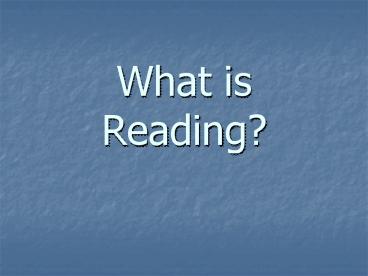What is Reading - PowerPoint PPT Presentation
1 / 16
Title:
What is Reading
Description:
Putting sounds together to make words. Reading is learning to ... How did you learn to ride a bike? What information do we use as we read? Semantic information ... – PowerPoint PPT presentation
Number of Views:88
Avg rating:3.0/5.0
Title: What is Reading
1
What is Reading?
2
- Twas brillig and the slithy toves
- Did gyre and gimble in the wabe
- All mimsy were the borogroves,
- And the mome raths outgrabe
- Lewis Carroll, Through the Looking Glass
3
What is reading?
- Its filling out workbooks
- Pronouncing letters
- Putting sounds together to make words
- Reading is learning to read hard words
- Reading is like thinking . . You know, its
understanding the story - Its like when you find out things
- Harste, 1978
4
What is Reading?
- Learning letter-sound relationships and then
using that knowledge to decode words letter by
letter - Being fluent being able to read all the words
in a text accurately and smoothly - Constructing meaning, and using everything you
know to do it
5
How did you learn to ride a bike?
6
What information do we use as we read?
- Semantic information
- Meaning cues from each word and sentence and from
the evolving whole as you progress through a text - Syntactic information
- Grammatical cues like word order and word endings
- Graphic and grapho-phonic information
- Cues from letters and letter patterns combined
with our knowledge of letter-sound patterns
7
The Clolf in Weeps ShothingThere was once a
wig bolf who trew gired of funting for his hood.
Its such ward hork and its no shun being fot
at by fad marmers, he said.Ho se thought of a
plever clan. De hecided to hap wrimself in a
leepskin and shive in a peep shen.
8
Reading is an Interactive Process
M E A N I N G
Reader constructs the message through -
background knowledge - knowledge of text types
- selecting cues - predicting -
confirming or correcting
Printed Text Provides information - semantic
cues - syntactic cues - graphophonic cues
9
How would you illustrate this story?
- The siblings were playing at the table, and
the older one was winning. Their mother came
into the room, and when she saw what was
happening she told him to let his sister win once
in awhile. Then she told them to clear the table
because their father would be home shortly and it
would be time to eat.
10
Models of Reading and Writing
- 1. Bottom-Up
- 2. Top-Down
- 3. Interactive
11
Approaches to Reading Instruction
- Phonics approach
- Sight-word approach
- Linguistic approach
- Language Experience Approach
- Basal Reader Approach
- Whole Language Approach
- Balanced Reading Approach
12
Applying these ideas to the Articles
- What model of reading seems to be held most
closely by this author? - What evidence from the article leads you to that
conclusion? - What questions would you like to ask of these
authors? - Whose arguments do you find most compelling?
13
Stricklands Whole-to-Part-to-Whole Framework
Blending Skills with Meaning
- WHOLE to PART to WHOLE
- Learning with, Learning about Learning to
- through and how the parts apply what
- about whole (textual features) was
learned - Texts of language function with, through
- in written texts and about
- written texts
14
Interpreting the TORP
- Scoring
- Tally the total score giving each answer the
numerical value given except for - Numbers 5, 7, 15, 17, 18, 23, 26 27, where you
reverse the numerical value (e.g. 15, 24, etc)
15
The Continuum of Theoretical Orientations
- Phonics Skills Whole
- Language
- 0 65 65 110 110 - 140
16
Paradigms for Teaching Language and Literacy
- The Transmission Approach
- The Transactional or Constructivist Approach































